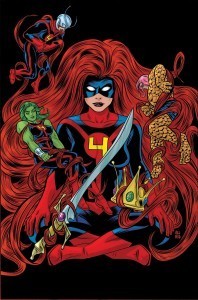Magen Cubed's Blog, page 25
April 12, 2013
Comic book review: Avengers #9
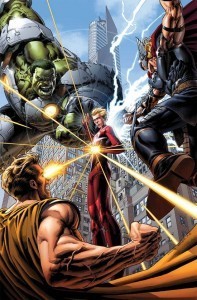 What good is a White Event if only leads to the destruction of the planet it was meant to transform? From writer Jonathan Hickman and artists Dustin Weaver and Mike Deodato.
What good is a White Event if only leads to the destruction of the planet it was meant to transform? From writer Jonathan Hickman and artists Dustin Weaver and Mike Deodato.
Allowing Ex Nihilo to reign on Mars might be the most costly mistake the Avengers have made, as seen in this issue from Hickman and artists Weaver and Deodato. As Nightmask and Starbrand seek Ex Nihilo and Abyss in The Garden, they discover that they themselves are what is broken in the system. Eager to play god himself, Ex Nihilo’s evolution bombs were encoded with specific instructions, traits designed to give the planet sentience. All of the quarantined zones undergo dramatic chain reactions meant to trigger planetary evolution, but banned from returning to Earth, Ex Nihilo will do nothing to stop it. Faced with the consequences of inaction, Starbrand and Nightmask return to Earth as a living brain begins developing on a beach in Croatia. It tries to consume Nightmask, and in trying to save him, Starbrand accidentally destroys the brain in a devastating blast.
The Avengers, radically unprepared for the reality of the situation, demand justice for the explosion at the college and try to take Nightmask and Starbrand into custody. Unwilling to go they fight back, the ensuing skirmish causing cataclysmic damage. The fight rages on until Starbrand realizes he and Nightmask are flawed products of a broken machine, and have to be controlled. They finally yield to seclusion in a space station above Earth’s orbit until the Avengers can find a better alternative, and find out the repercussions of killing a planet’s consciousness.
Hickman poses a lot of wild ideas and moral problems in this issue, and delivers a very eerie prelude to a larger, more ominous story. My only problem with this situation, however is the team’s total lack of forethought. They have spent a great deal of time trying to contain Starbrand without looking at the greater issue of leaving Ex Nihilo to his own devices on Mars or what he endgame is. There are a lot of massive, world-breaking crises going on here, and the Avengers’ reaction so far has appeared really hasty and thoughtless. Yes, Starbrand and Nightmask are unpredictable and flawed, but so is the team itself, by the looks of things. I understand Hickman had to take the focus off Ex Nihilo for a while, but at the cost of believable characterization.
Beyond that, the writing works for me, and these hindrances are made up for with Weaver and Deodato’s artwork. The action sequences are nothing short of spectacular, and very setting of the evolutionary change is uniquely rendered with such gorgeous detail as to really individualize the processes at work. Despite a few setbacks, this is a solid and interesting issue with great visuals.
April 5, 2013
Comic book review: Deadpool #7
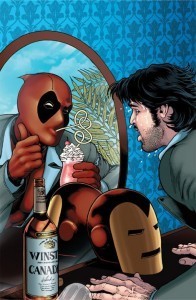 A flashback to Deadpool’s adventures in yesteryear with Iron Man! From Brian Posehn and Gerry Duggan with art from Scott Koblish.
A flashback to Deadpool’s adventures in yesteryear with Iron Man! From Brian Posehn and Gerry Duggan with art from Scott Koblish.
It’s a time for a ‘80s flashback as artist Scott Koblish takes a crack at Deadpool’s antics, with the help of Val Staples’ fun retro colors. Full of fourth-wall bending, guest appearances and jokes only seasoned readers would understand, this issue proves to be a fairly entertaining detour from all the zombies. Employed by a demon, Deadpool is sent to get Tony Stark back on the bottle and make sure he crashes his company (and Iron Man) for good. While the deal is too sweet to pass up, when Deadpool finds a despondent Stark hiding in flophouse, he has a change of heart.
After helping Stark sober up and make the move to get his life back together, Deadpool gets trashed and dons the armor. He does what he can to deal with a nuclear catastrophe and embarrass Iron Man on the national stage in the process, giving Stark enough problems to keep him busy for the foreseeable future. With Iron Man knocked down a peg or two, Deadpool completes his contract and saves Stark from the demon dealing, leaving him to work on himself in the meantime. Cable conveniently arrives at the end to lead into the next adventure, saving the reader from the discomfort of any moral lessons or character development.
While still suffering from the cheesy dialogue that has so far plagued the series, the art is the main draw of this issue. Koblish’s pencils lovingly rip on this bygone era with strong compositions and dynamic designs, which carries the story with a fair complement of clever visual gags. Iron Man fans will get a kick out of the appearance, as well as the allusion to this classic era of the character’s history. It’s not brilliant storytelling, but it’s fun in a way this series really hasn’t been. Then again, I am one of those sadistic Iron Man fans who likes to see him made fun of (because, seriously?), so it could just be my bias showing.
April 3, 2013
Full disclosure: A deeper look at Marvel NOW’s Captain America
We have moved well into the first leg of Rick Remender’s opening arc of Captain America, following Steve Rogers in the apocalyptic wasteland of Armin Zola’s nightmarish Dimension Z. As it stands today, Steve has moved far and away from who he was at the start. He is over a decade older; he is haggard and battle-scarred, without the luxury of powerful friends and A-List guest stars to bail him out. A single father, he is charged with caring for his son Ian, the heir he stole from Zola’s clutches, raising him to the best of his limited ability in the face of constant danger. Steve has only his wits and his resolve to keep him alive, and even for it, he is flawed. He is tired. He makes mistakes. He is unsure of himself. He is something else entirely from the Sentinel of Liberty we have taken for granted.
This is not the Captain America we have all come to know and love, especially in recent years, under the consistent authorship of longtime series writer Ed Brubaker. This is not the Captain America a lot of new readers came to read, that elusive target audience Marvel NOW is attempting to reach in the aftermath of the Marvel Cinematic Universe movies. The creature Remender has created for this series is a completely different character, dropped into a hellish landscape and stripped of his power and authority. And while this Steve Rogers is not the one we came to read, this is the truest, realest, most distilled Steve Rogers I have personally read in a long time.
N ow, let me be clear: This is not a flawless series. I would argue that only the current runs of Hawkeye and Young Avengers have earned that title in my book, but that is because I worship at the respective altars of Fraction and Gillen. Also, they are cool guys. (I follow them on Tumblr. I have proof.) I am not the biggest fan of John Romita, Jr.’s artwork, and, as equally proven by his time on Uncanny Avengers so far, Remender is prone to bouts of redundant narration. That, and he seems to be unable to control himself when faced with the completely gratuitous opportunity to have Captain America drop to his knees and scream to the heavens about just how much he loves America. (We have memes for that, okay? Also, we have Ultimate Captain America, who is the biggest patriotic patriot to ever patriot. America is his White House, the A doesn’t stand for France, don’t tread on my Iron Man, blah blah blah.) Having characters shout anything to the heavens begs for camp, but these are my only nitpicks about a series that has otherwise really impressed me.
ow, let me be clear: This is not a flawless series. I would argue that only the current runs of Hawkeye and Young Avengers have earned that title in my book, but that is because I worship at the respective altars of Fraction and Gillen. Also, they are cool guys. (I follow them on Tumblr. I have proof.) I am not the biggest fan of John Romita, Jr.’s artwork, and, as equally proven by his time on Uncanny Avengers so far, Remender is prone to bouts of redundant narration. That, and he seems to be unable to control himself when faced with the completely gratuitous opportunity to have Captain America drop to his knees and scream to the heavens about just how much he loves America. (We have memes for that, okay? Also, we have Ultimate Captain America, who is the biggest patriotic patriot to ever patriot. America is his White House, the A doesn’t stand for France, don’t tread on my Iron Man, blah blah blah.) Having characters shout anything to the heavens begs for camp, but these are my only nitpicks about a series that has otherwise really impressed me.
The core of this book has been Steve’s relationship with his mother, Sarah. In this current iteration of his backstory, Steve is the impoverished product of a broken home during Depression-era Brooklyn, a sickly boy terrorized by his abusive drunk of a father. It is only in watching his mother stand up to his father that a young Steve learns the moral code that would later dictate his entire ethos. Stand up to bullies wherever you find them. Do not wane in the face of brutality. Never back down. These are the principles that define Steve, and certainly, poignantly, come to underscore his story. Of Sarah and Steve, Remender told CBR,
“This woman raised him on her own, with no money, during the Great Depression. Through all the hardships they faced, she continued to impart on him that you cannot allow difficult circumstances to change you. That you always have to stand up for and help protect those in need. Steve has followed that to such a degree that he’s almost obsessed with it. He’s intent on showing his mother that he’s going to live up to this challenge she set out for him. None of that challenge, though, was, ‘Settle down and have a family.’ It was all about these ethical ideas and this moral compass that she built into him instead of having a life and being normal. If you look at the history of the character, he’s always washed that away.”
Which, of course, leads me to my next point. But before that, I would like to say how much I love Sarah’s impact on Steve’s story. The idea of having the mother impart this knowledge and strength to the son is not a convention I often encounter, in a genre where the relationships of fathers and sons are privileged above most others. I think we most often see this with mothers and daughters, in the archetypal origin stories of female characters. Narrative convention typically shows us women who grow up in the face of persecution, cruelty and violence, coming out of these experiences to act as a steward of the marginalized and help them navigate the corridors of social oppression. Young Steve must rise above his class struggles, illnesses and ultimately his inherent lack of power to prove that he is a stronger person than those who would try to brutalize him. Through his mother’s love and strength, Steve gains his own agency, which he employs as an adult through his training and enhanced physical abilities to further the principles she taught him.
Is this a story that we often see assigned to white male characters? Yeah, um, no.
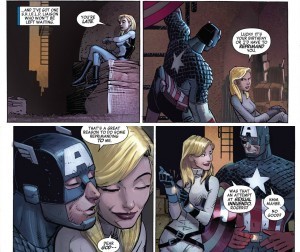 But now I have to talk about Sharon Carter. I am going to be honest: I am not a Sharon fan. Which is not to say that there is anything wrong with the character, who is fine on her own. I just personally feel that Sharon is often shoehorned into Steve’s life, despite numerous break-ups and generally unsatisfying relationship development, because writers seem to be convinced that Steve needs a girlfriend. A girlfriend, as we see in the first issue, who goes so far as to propose to Steve. Steve, as he is wont to do when faced with a personal problem, pushes the whole thing aside. Why? The reality is, Steve does not need a girlfriend, because Steve does not even know what he wants. One could even argue that – well, there is no Steve Rogers. It has been pretty much confirmed by Remender that Steve, burdened by the task of living up to his mother’s expectations, has no life beyond the shield. (I would like to keep this from getting Freudian, as I do not believe he holds anyone up to his mother, just that he is consumed by her ideals. Which, yeah, I guess is a little weird, but whatever. Take your complex somewhere else, Oedipus.) He has completely abandoned his personal life to commit himself to the ideals of Captain America, which is now all he has.
But now I have to talk about Sharon Carter. I am going to be honest: I am not a Sharon fan. Which is not to say that there is anything wrong with the character, who is fine on her own. I just personally feel that Sharon is often shoehorned into Steve’s life, despite numerous break-ups and generally unsatisfying relationship development, because writers seem to be convinced that Steve needs a girlfriend. A girlfriend, as we see in the first issue, who goes so far as to propose to Steve. Steve, as he is wont to do when faced with a personal problem, pushes the whole thing aside. Why? The reality is, Steve does not need a girlfriend, because Steve does not even know what he wants. One could even argue that – well, there is no Steve Rogers. It has been pretty much confirmed by Remender that Steve, burdened by the task of living up to his mother’s expectations, has no life beyond the shield. (I would like to keep this from getting Freudian, as I do not believe he holds anyone up to his mother, just that he is consumed by her ideals. Which, yeah, I guess is a little weird, but whatever. Take your complex somewhere else, Oedipus.) He has completely abandoned his personal life to commit himself to the ideals of Captain America, which is now all he has.
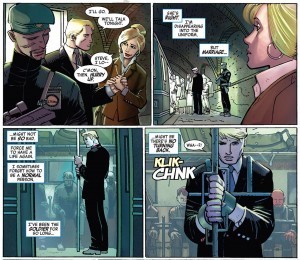 While his relationship with Sharon is inherently sweet, it reads as lip-service. Her marriage proposal is kind of the sad nail in the coffin that is Steve’s life: He loves her, but he cannot commit. He has nothing to give her, because he has become the passive observer of his own life. There is no future to build together, because for Steve, there is only the dream. (So can we at least just cut Sharon loose once and for all? Pretty please? Let the girl get it from somebody willing to commit, amirite?) Tragic? Yes. Kind of typical? Maybe. Smacks a little of Batman? Yeah, I know. But that is where Ian comes in and the story starts to get interesting.
While his relationship with Sharon is inherently sweet, it reads as lip-service. Her marriage proposal is kind of the sad nail in the coffin that is Steve’s life: He loves her, but he cannot commit. He has nothing to give her, because he has become the passive observer of his own life. There is no future to build together, because for Steve, there is only the dream. (So can we at least just cut Sharon loose once and for all? Pretty please? Let the girl get it from somebody willing to commit, amirite?) Tragic? Yes. Kind of typical? Maybe. Smacks a little of Batman? Yeah, I know. But that is where Ian comes in and the story starts to get interesting.
Before anyone starts in on the parallels between Batman collecting young wards and Captain America stealing a child to raise as his own, stop. This is more like The Road than Batman, wherein Steve confronts starvation, violence and warring monster tribes in his effort to care for his adopted son. They trudge through the desert and sleep in makeshift camps at night; when after Ian falls asleep Steve looks at the single bullet he keeps with him, engraved with the word Diligence, to keep from giving up. Through Ian, Steve is finally shocked out of his malaise of service and duty to accept that there are things bigger than his Captain America persona. Ian gives him something to live for beyond his ideals, which is not to say that their relationship is not complicated. It is sometimes messy.
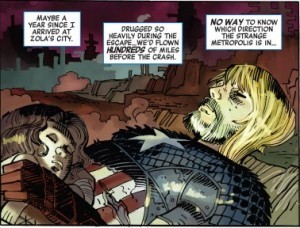 Steve is not equipped to deal with raising a child, let alone by himself. Ian is a rebellious boy with a lot of questions. As a father, Steve wants to impart to Ian all the things that his own mother taught him, but this is a far different world than the one that he comes from. For this, Steve is often critical of himself and his inability to meet all of these challenges the way he would like to. He makes mistakes, he has regrets, but he is still hanging on. In this way, he has become his mother, their stories running parallel to each other.
Steve is not equipped to deal with raising a child, let alone by himself. Ian is a rebellious boy with a lot of questions. As a father, Steve wants to impart to Ian all the things that his own mother taught him, but this is a far different world than the one that he comes from. For this, Steve is often critical of himself and his inability to meet all of these challenges the way he would like to. He makes mistakes, he has regrets, but he is still hanging on. In this way, he has become his mother, their stories running parallel to each other.
As Zola closes in and Steve, weakened and enfeebled by Zola’s consciousness virus, must struggle against his own deteriorating condition to care for his boy. Just as a young Steve watched disease eat away at his mother, Ian has had to watch Steve decline after years of struggle and survival. This must be excruciating for Steve, who has worked so hard to preserve his mother’s memory and strength, only to put his own child through the similar pain of standing by while a parent slowly dies. So much so that, when Zola and his warrior daughter Jet steal Ian back, Steve cuts the Zola virus out of his chest, breaking the screen and with it Zola’s influence over him. Bleeding out, his chest a gaping wound of exposed wires and tissue, he resolves to end this fight once and for all.
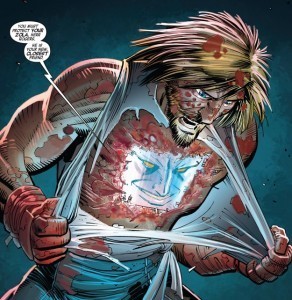 In a genre where the relationships between fathers and sons are privileged, a single father, spurred on by his mother’s teachings, wills himself back from the edge of death to rescue his child. In a story that parallels his own childhood of crushing poverty and domestic abuse, Captain America pulls himself up to do the best that he can in an impossible situation. In a narrative that completely breaks down a much-beloved character and reassembles him piece by piece, this book has found a way to make Steve Rogers a better version of himself in stripping him of everything we know. Remender has made an interesting case for Captain America in this series, grounded by poignant character development and innovative settings. While not a perfect book, this is one of the few titles under Marvel NOW’s umbrella that truly lives up to the hype of “all new, all different.” For that reason, I am excited to see where it takes Captain America in the bleak future of Dimension Z.
In a genre where the relationships between fathers and sons are privileged, a single father, spurred on by his mother’s teachings, wills himself back from the edge of death to rescue his child. In a story that parallels his own childhood of crushing poverty and domestic abuse, Captain America pulls himself up to do the best that he can in an impossible situation. In a narrative that completely breaks down a much-beloved character and reassembles him piece by piece, this book has found a way to make Steve Rogers a better version of himself in stripping him of everything we know. Remender has made an interesting case for Captain America in this series, grounded by poignant character development and innovative settings. While not a perfect book, this is one of the few titles under Marvel NOW’s umbrella that truly lives up to the hype of “all new, all different.” For that reason, I am excited to see where it takes Captain America in the bleak future of Dimension Z.
March 30, 2013
Why publishing is bad for writers
Publishing bruises the author’s ego. It breaks down the thin skin protecting little words like “artist” and “genius” and stomps them into the dirt. It turns what is inside to the outside through monetization and public autopsy. If writing is the act of catharsis, publishing is flagellation. Confession meets self-dissection. The postmortem is the first indication that the author is likely not as good as he thinks he is. And needs a chainsaw to get through his edits. And had better be ready to shake his ass like nobody’s business, especially if he expects to sell this damn book to somebody outside of his mom and Facebook friends list.
Publishing exposes the author to mediocrity. It is the cold black reality that the best intentions do not mean anything if nobody gives a crap about the story. It is the risk of failure. It is the management of expectations. Everything about this should be terrifying, because there is no proven formula to fall back on. All the easy cheat books and Sparknotes will not help the author now. Yes, he can write a novel in thirty days. No, that does not mean he should try to sell it. If he is looking for fame and fortune, he should have gone into politics.
Publishing is the truth that there are not enough hours in a day. It is the shortage of greedy hands to slap hot books into. There will never be enough book signings or blog tours, interviews or mailing lists. There will never be a pole long enough to work this book quite the way the author wants to. He can only shake his ass for so long before the Amazon rankings and bestseller lists move on to the next best thing. If he is good, he can write something else, strap back in and do it all again. If he is expecting this ride to last forever, well. Never quit your day job.
Publishing is an ongoing experiment. It is a continuing story. Maybe it is a car wreck in slow motion. There are no quick fixes or short cuts; just new adaptations, strategies, ways of survival.
So why try to get published?
I will get back to you on that one.
March 28, 2013
Comic book review: Uncanny Avengers #5
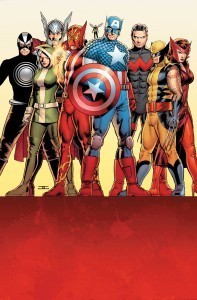 Wonder Man, Wasp and Sunfire join the team just in time for Grim Reaper’s revenge! Tension between the team builds as Havok’s leadership is questioned! The death of a major character at the hands of an Avenger in broad daylight! From Rick Remender and Olivier Coipel.
Wonder Man, Wasp and Sunfire join the team just in time for Grim Reaper’s revenge! Tension between the team builds as Havok’s leadership is questioned! The death of a major character at the hands of an Avenger in broad daylight! From Rick Remender and Olivier Coipel.
Tensions continue to threaten the foundations of this shaky alliance between Avenger and X-Man in this issue. Remender lays the groundwork for future plots as another threat emerges from Akkaba City. The twin heirs of Apocalypse are born, much to the worry of Kang, who has spent thousands of years attempting to stop their rise to power. As we join him in the beginning of the issue, he has now hatched a plot to win the future for himself.
Meanwhile, the Avengers are preparing for a press conference to address the Red Skull’s psychic attack on New York City and the senseless deaths of hundreds of mutants. Wasp and Wonder Man arrive as P.R. experts as Captain America hands power of the Unity Division over to Havoc. Jan plans to bankroll the unit, freeing them from the strings of government sponsorship, but tempers flare as in-fighting continues within the team over Alex’s capacity as a leader. In Tokyo, Wolverine finds Sunfire drinking himself into a stupor over the birth of the Apocalypse Twins, and convinces him to come back to the fight to help bolster the team.
Copiel’s pencils steal the show in this tense and well-paced issue, concluding in a stunning fight scene that leaves more questions than answers. His art feels like a better complement to the story over Cassaday’s somewhat stiff style, and really captures a lot of the emotional subtleties both within and between these characters. As far as the writing goes, Remender offers a strong effort, with tight plot development and character dynamics. However, his work does suffer from the usual pitfalls of redundant narration, as well as some cheesy dialogue toward the backend of the book.
Despite these nitpicks, this is the first truly great issue of this series so far.
Comic book review: FF #5
The mystery that is…Medusa! From Matt Fraction and Mike Allred.
Fraction and Allred deliver another solid episode as the mysteries surrounding Old John and Medusa continue to unfold. Scott is having trouble keeping the team (and himself) together in the wake of his very public fight with Alex Power, who has since left for Doomstadt to address the Doctor Doom issue on his own. Darla, still trying to make the best of a bad situation, tries to rein Scott back in, but there’s little time for that as Old John goes on a rampage and starts burning down the city. With a little intervention from a sea monster allied with Vil and Wu of the Future Foundation, the team is able to take Old John back into their custody. Meanwhile, the truth behind Medusa’s strange behavior comes to light as Bentley-23 wakes to find he is no longer at the Baxter Building, and things are not at all what they seem.
Full of clever visual gags and Fraction’s brand of low-key humor, this issue doesn’t disappoint. The endearing weirdness is again matched by subtle character development as the dynamics of the team continue to grow and change every month. Another enjoyable read from a series that has only gotten better.
Hot new fiction: Demons, demons, demons

New this week from Western Legends Publishing, the first part of The Demonologia Biblica series is out. It features my latest short story, O for Onoskelis, which is about demon deals, nightclubs and dirty little secrets. A guy named Harvey is in it, and his sister Scarlett, too. I think they’re fun. Sound good?
The Demonologia Biblica: compiled and edited by Dean M. Drinkel. The first in a collection of anthologies to be published by Western Legends throughout 2013 under the banner “Tres Librorum Prohibitorum”. A lexicon of demons full-to-bursting with great writers (some new, some award nominated, some award winning) from all around the world.
Cool. You can pick it up today digitally and in print on Amazon. And it’s cheap, man. You don’t even have an excuse this time.
March 27, 2013
Comic book review: Young Avengers #3
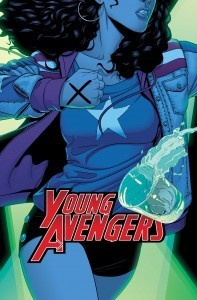 A Fight scene, probably. And another one, but this time in a club.Plentiful feels. (aka “Meaningful emotional character beats” for people who aren’t on Tumblr.) The fakest ID in history. From Kieron Gillen and Jamie McKelvie.
A Fight scene, probably. And another one, but this time in a club.Plentiful feels. (aka “Meaningful emotional character beats” for people who aren’t on Tumblr.) The fakest ID in history. From Kieron Gillen and Jamie McKelvie.
It seems Loki’s attempts to keep Billy from resurrecting Teddy’s mother have some unintended consequences as Laufey returns to beat them all into oblivion. Their parents have become pod people (or not-dead, in the case of Laufey and Teddy’s mother), wreaking havoc for everyone. The explosive arrival of Miss America on the scene works to their advantage, as Loki is able to teleport them to M.J.’s in New York to work on a strategy to stop their murderous parents. However, there’s little time to workshop before Teddy’s mother, flanked by Billy and America’s respective brain-washed families, show up to make matters worse.
Another whip-smart issue from Gillen, with brilliant dialogue and character dynamics throughout. McKelvie’s design work is clever as ever, marked by dynamic panel changes and action sequences. The humor, action character drama are well balanced, which keeps the story moving at an engaging pace. Everything about this book is slick, modern and fun. Flawless from start to finish.
March 24, 2013
The weather from under the bridge: Writing and real life
Okay, so, two things you need to understand about this blog these days:
1) It’s mostly comic books, in case you haven’t noticed the distinct lack of original content. I now write weekly reviews for upwards of fifteen books over at MARVEL Disassembled. Occasionally I get hate-mail from butthurt Tumblr fanboys who feel I’m doing their lifestyle a disservice but not raving about the latest issue of Whatever-the-Hell. Most of the time I get nice mentions from the writers themselves because I manage to not spew hateful vitriol about their work every single month. (Or, if I do spew hateful vitriol, I try to back it up with a bunch of fancy book-words I learned in college.) Overall, it’s been pretty good.
2) About those fancy book-words. I am now enrolled full-time in college in order to learn them. I also work part-time. Basically, I write at least one paper a week, then come home and write about comic books all day. In my spare time, I try to work on my original fiction. As you can tell, that doesn’t leave much time for keeping a fun and interesting blog full of fun and interesting things. So you get a lot of comic book reviews instead. Congratulations?
Anyway, the real reason I’m writing this now, beyond just letting people know that I’m not actually curled in a blanket-burrito regretting my decision to go back to school (Who, me?), is that lately I’ve gotten a lot of questions about my writing from the depths of the internet. I don’t know why people are taking the time to write me questions, whether on Twitter or Tumblr. I’m not exactly prolific, and I’m not exactly well-known. But, I guess I should probably be a decent human being and respond to them, because these people were nice enough to ask.
Have you ever written a novel?
Yes. A long, long time ago, when I actually had hopes of publishing professionally, I wrote a psychological horror fiction novel called Flesh Trap. I talked it up for a while; you probably suffered through numerous descriptions and chapter excerpts without even realizing what it was. It was released as a free-to-read weekly serial for about six months, wherein it was open to the public and anybody could read it and all that stuff.
That sounds so cool, are you going to get it published?
No. Well, yes. But no. It was technically already published as a serial, so that counts. Will a publisher ever pick it up? I doubt it. I’ve sent it out to a few publishing entities in the last year, but I have no real hopes for getting this project off the ground. It was my first completed novel, and as such feels like a really freshman effort. Now that I’ve had some distance between myself and the manuscript, I can see that. So, oh well. Maybe one day when I can bear to look at it again, I can give it another go-around, but today is not that day.
Are you working on anything else?
Yes. Five other books, in fact. I’ve kind of given up on writing short stories, though; it’s a non-existent market, and I don’t have the name recognition to carry anything on my own. If I feel like getting something off my chest I jot down a comic script and go from there. Because, you know. Comics.
What is your current project about?
It’s still early days, but I’m currently entrenched in a five-part superhero fiction series called The Crashers. I’ve written a little bit about it already, although I also routinely harass the denizens of Tumblr with random bits and bobs from the project, as well. Basically? It’s my take on deconstructionist superhero fiction, wherein I take a group of archetypal characters and kind of just destroy them in an effort to open a dialogue about the mythic nature of the genre itself. This is pure existentialism: A little Watchmen, a little Earth X, and a whole hell of a lot of Misfits. I want it to be warm and familiar, full of people you can easily recognize and relate to, whose lives you’re deeply invested in. And then I want to punch you in the gut, ruin your favorite character’s life, and make you cry. So, yeah.
Do you want to get this published?
I mean. Yeah, that would be awesome. But superhero fiction is a niche market, and…I don’t think anybody actually reads superhero fiction? I dunno. I kind of have a feeling I’ll have to beg for money on a Kickstarter page and publish it on my own as a serial with some proper marketing, but we’ll cross that bridge when we get to it.
Would you ever consider self-publishing?
Like, a physical edition that I expect people to pay money for? No, I wouldn’t. Not unless I had considerable name recognition and some money lying around in order to do it with some level of professionalism. I wouldn’t even do an ebook unless I could get it out in such a way that it would actually reach people. I fear the slush pile. The slush pile gives me hives.
Does that about cover it? Thank you for your questions, faceless denizens of the internet. I only wish I could be less cynical and profit-motivated, but, you know, I am a broke college student. Cash rules everything around me and all that. (Dollah dollah bills, y’all.) If you ever want to bother me, shoot me a message at magencubed@gmail.com, or harass me on Tumblr, Twitter or Facebook. Or, you know, smoke signals work too, I guess.
March 22, 2013
Comic book review: New Avengers #4
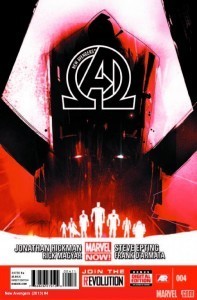 The Illuminati have learned that Earth is the center point for the death of the Universe. From Jonathan Hickman and Steve Epting.
The Illuminati have learned that Earth is the center point for the death of the Universe. From Jonathan Hickman and Steve Epting.
The tensions in the Illuminati’s uneasy alliance continue to wear at the foundations in this issue. As Reed and T’Challa race to develop a capable of destroying a universe, Tony harvests the power of our sun. Strange, however, sees little use for science as he resolves to use the Blood Bible to end this crisis, leaving Wong to tend to his estate in the almost-certain event of his death. As an incursion point opens over Ellis Island, any hope of hiding the impending catastrophe is now moot.
The group assembles, where Hank proposes they travel to the other side of the incursion to locate the Infinity Gems of that universe. He believes they can use them to buy themselves more time, which appears a little hypocritical, as they just expelled Steve Rogers from the council for executing an almost identical plan. If they did this, it would force one of them to remain on the other side to use the gems, and be destroyed in the process. Running out of time and resigned to the plan, the group travels to the other side of the incursion. There they discover a mutant-run Earth being descended up by Galactus, the focal of this incursion, as Galactus consumes this world in an attempt to stop the death of reality.
So does the Illuminati – composed of self-proclaimed who have battled Galactus before – stop him and spare this Earth death at his hands, or do they allow him to do their dirty work for them?
Hickman continues to pose a lot of complex moral questions with this series, and this issue is no exception. The story in is tight and fascinating, and gives little away while still leaving the reader to form his/her own opinion of these characters’ decisions. Nobody is being depicted as right or wrong, just shown in mitigating shades of gray. Epting’s art is as always engaging and cinematic, and carries things along strongly. Another highly enjoyable read.



